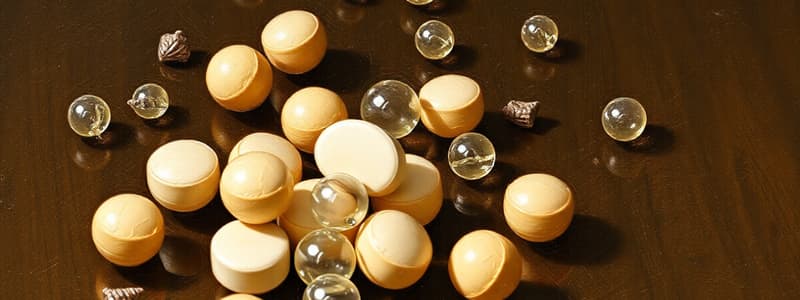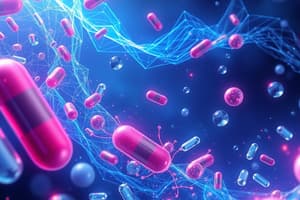Podcast
Questions and Answers
What role do lipoproteins play in the body?
What role do lipoproteins play in the body?
- Facilitating muscle contraction
- Transporting lipids in the blood (correct)
- Storing excess energy as fat
- Transporting water-soluble vitamins
Which of the following lipoproteins is considered 'bad cholesterol'?
Which of the following lipoproteins is considered 'bad cholesterol'?
- High-density lipoprotein (HDL)
- Chylomicrons
- Very-low-density lipoprotein (VLDL)
- Low-density lipoprotein (LDL) (correct)
What is the primary mechanism of action of HMG-CoA reductase inhibitors?
What is the primary mechanism of action of HMG-CoA reductase inhibitors?
- Inhibit HMG-CoA reductase, reducing cholesterol production (correct)
- Enhance HDL levels in the plasma
- Increase triglyceride production
- Inhibit cholesterol absorption in the intestines
Which of the following is a potential adverse effect of statins?
Which of the following is a potential adverse effect of statins?
Which factor is NOT considered a modifiable risk factor for coronary artery disease?
Which factor is NOT considered a modifiable risk factor for coronary artery disease?
Which type of drugs primarily inhibits cholesterol absorption?
Which type of drugs primarily inhibits cholesterol absorption?
What is the result of increased liver LDL receptors as a mechanism of statins?
What is the result of increased liver LDL receptors as a mechanism of statins?
What is a characteristic of very-low-density lipoprotein (VLDL)?
What is a characteristic of very-low-density lipoprotein (VLDL)?
What is the primary function of high-density lipoprotein (HDL) in the body?
What is the primary function of high-density lipoprotein (HDL) in the body?
Which of the following groups of lipid-lowering drugs includes statins?
Which of the following groups of lipid-lowering drugs includes statins?
What is the role of HMG-CoA reductase in cholesterol synthesis?
What is the role of HMG-CoA reductase in cholesterol synthesis?
Which of the following is a characteristic risk factor for coronary artery disease?
Which of the following is a characteristic risk factor for coronary artery disease?
What effect do statins have on plasma low-density lipoproteins (LDL)?
What effect do statins have on plasma low-density lipoproteins (LDL)?
Which of the following statins is newer and is indicated to be used in low doses for Asian populations?
Which of the following statins is newer and is indicated to be used in low doses for Asian populations?
What is the primary composition of lipoproteins?
What is the primary composition of lipoproteins?
Which of the following statements about very-low-density lipoprotein (VLDL) is incorrect?
Which of the following statements about very-low-density lipoprotein (VLDL) is incorrect?
What is the role of chylomicrons in lipid transport?
What is the role of chylomicrons in lipid transport?
Which of the following statements correctly identifies the effect of statins on plasma low-density lipoproteins (LDL)?
Which of the following statements correctly identifies the effect of statins on plasma low-density lipoproteins (LDL)?
Which of the following is NOT a modifiable risk factor for coronary artery disease?
Which of the following is NOT a modifiable risk factor for coronary artery disease?
What is the primary mechanism by which HMG-CoA reductase inhibitors lower cholesterol levels?
What is the primary mechanism by which HMG-CoA reductase inhibitors lower cholesterol levels?
Which type of lipoprotein is primarily responsible for transporting triglycerides to cells?
Which type of lipoprotein is primarily responsible for transporting triglycerides to cells?
Which of the following is a characteristic of high-density lipoprotein (HDL)?
Which of the following is a characteristic of high-density lipoprotein (HDL)?
What is a common adverse effect associated with the use of statins?
What is a common adverse effect associated with the use of statins?
Why is the LDL/HDL ratio significant in assessing coronary artery disease risk?
Why is the LDL/HDL ratio significant in assessing coronary artery disease risk?
Flashcards
Lipoproteins
Lipoproteins
Lipid (cholesterol, triglycerides, others) molecules combined with proteins for transport in the blood.
Chylomicrons
Chylomicrons
Lipoproteins formed in the gastrointestinal tract that transport dietary lipids.
VLDL
VLDL
Very low-density lipoprotein, produced by the liver, primarily carrying triglycerides to cells.
LDL
LDL
Signup and view all the flashcards
HDL
HDL
Signup and view all the flashcards
HMG-CoA
HMG-CoA
Signup and view all the flashcards
HMG-CoA Reductase Inhibitors
HMG-CoA Reductase Inhibitors
Signup and view all the flashcards
Statins
Statins
Signup and view all the flashcards
What are the primary forms of lipids found in blood?
What are the primary forms of lipids found in blood?
Signup and view all the flashcards
What is a lipoprotein?
What is a lipoprotein?
Signup and view all the flashcards
What is the role of chylomicrons?
What is the role of chylomicrons?
Signup and view all the flashcards
What is the role of VLDL?
What is the role of VLDL?
Signup and view all the flashcards
What is LDL known as and why?
What is LDL known as and why?
Signup and view all the flashcards
What is HDL known as and why?
What is HDL known as and why?
Signup and view all the flashcards
Why is the LDL/HDL ratio important?
Why is the LDL/HDL ratio important?
Signup and view all the flashcards
What is the main target of HMG-CoA reductase inhibitors?
What is the main target of HMG-CoA reductase inhibitors?
Signup and view all the flashcards
What are the primary forms of lipids in the blood?
What are the primary forms of lipids in the blood?
Signup and view all the flashcards
What are lipoproteins?
What are lipoproteins?
Signup and view all the flashcards
How do statins reduce LDL cholesterol levels?
How do statins reduce LDL cholesterol levels?
Signup and view all the flashcards
Study Notes
Lipid Lowering Drugs (Antilipemic Drugs)
- Lipid lowering drugs, also known as antilipemic drugs, are used to manage plasma lipid levels.
- Lipoproteins are combinations of lipids and proteins that transport lipids in the blood.
- Triglycerides (TGs) and cholesterol are the primary forms of lipids in the blood.
- These lipids are water-insoluble and must be packaged for transport in the blood.
- Lipoproteins have a hydrophilic shell composed of phospholipids and carry a hydrophobic core of cholesterol and triglycerides.
Lipoprotein Types
- Chylomicrons: Produced in the gastrointestinal (GI) tract.
- Very-low-density lipoprotein (VLDL): Produced by the liver, transports triglycerides to cells.
- Low-density lipoprotein (LDL): Often called "bad" cholesterol due to its role in plaque formation in arteries; rich in cholesterol, essential for cell membranes and steroid hormones.
- High-density lipoprotein (HDL): Often called "good" cholesterol; responsible for cholesterol recycling, which benefits the body.
Coronary Artery Disease
- Non-modifiable factors for CAD include:
- Age (Males ≥ 45, Females ≥55 or postmenopausal)
- Strong family history of premature Coronary Artery Disease.
- Modifiable factors for CAD include:
- Current cigarette smoker
- Abdominal obesity
- Hypertension (BP ≥ 140/90 or on antihypertensive medication)
- Diabetes Mellitus
- Low-density lipoprotein/high-density lipoprotein ratio
Lipid Lowering Drug Groups and Mechanisms
- HMG-CoA reductase inhibitors (statins): These drugs inhibit the enzyme HMG-CoA reductase, an important liver enzyme responsible for cholesterol production. This lowers the rate of cholesterol production in the liver. By inhibiting HMG-CoA reductase, the liver produces more LDL receptors. This increases plasma clearance of LDL. This class of drugs also decreases VLDL and increases HDL.
- Examples include atorvastatin (Lipitor), rosuvastatin (Crestor), lovastatin (Mevacor), and simvastatin (Zocor). Rosuvastatin has demonstrated possibly less adverse effects in some clinical trials and lower doses might be utilized in Asian patients.
- Inhibitors of Cholesterol Absorption
- Niacin (nicotinic acid)
- Fibric acid derivatives
HMG-CoA Reductase Inhibitors: Mechanism of Action
- Inhibit HMG-CoA reductase, a vital liver enzyme involved in cholesterol synthesis.
- This action lowers the rate of cholesterol production.
HMG-CoA Reductase Inhibitors: Indications
- First-line therapy for hypercholesterolemia.
- Treatment for hyperlipidemias type IIa and IIb
- High LDL cholesterol levels.
HMG-CoA Reductase Inhibitors: Adverse Effects
- Mild, transient gastrointestinal (GI) disturbances, such as headache.
- Muscle pain (myalgia), and in rare cases, rhabdomyolysis (muscle breakdown).
- Liver injury (elevation of liver enzymes). Care is needed with patients with pre-existing liver dysfunction such as viral hepatitis.
- Statins are not used during pregnancy.
Considerations with Statins
- Asian patients may benefit from lower doses of specific statins. Rosuvastatin might be a preferred choice among this group.
- Grapefruit and grapefruit juice can inhibit CYP3A4, an enzyme involved in metabolizing some statins, and can lead to increased levels of statins in the blood, possibly having serious effects on anticoagulant users.
- Drug interactions with statins can occur with inhibitors of CYP3A4, such as warfarin (oral anticoagulant), erythromycin (macrolide antibiotic), and ritonavir (HIV protease inhibitor).
Studying That Suits You
Use AI to generate personalized quizzes and flashcards to suit your learning preferences.




